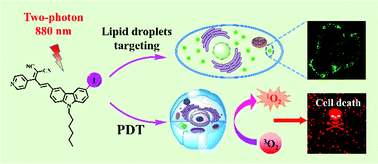Lipid droplets (LDs) are dynamic multifunctional organelles that participate in the regulation of many metabolic processes, visualization of which is necessary for biological research. In this work, a series of two-photon responsive fluorescent probes (C–H, C–Br, and C–I) based on carbazole units were designed and synthesized. Thereinto, an iodine-modified carbazole derivative C–I exhibited an exciting lipid droplet targeting ability due to its excellent lipophilicity. Meanwhile, benefiting from its larger Stokes shift and two-photon absorption cross-section, C–I was employed for two-photon confocal laser scanning microscopy (CLSM) and stimulated emission depletion (STED) microscopy imaging to observe LDs more accurately. In addition, given the heavy atom effect, C–I can effectively generate reactive oxygen species (ROS) leading to cancer cell apoptosis under near-infrared light irradiation. Notably, we explained the process of cell apoptosis through in vitro simulation experiments. This study provides a promising platform for visualization of lipid droplets.
